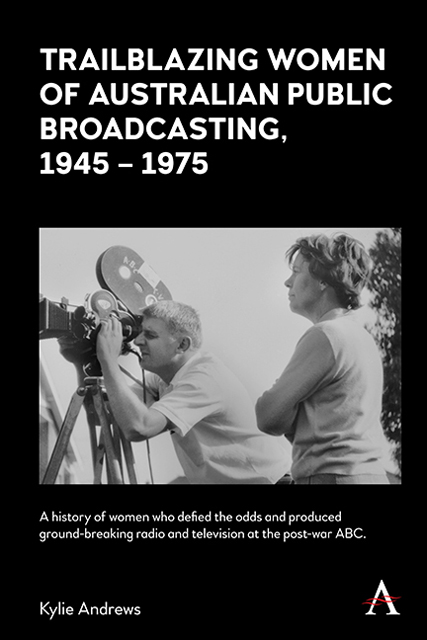Book contents
- Frontmatter
- Dedication
- Contents
- List of Figures
- List of Abbreviations
- Preface
- 1 Introduction
- 2 Career Snapshots
- 3 Welcome to the ABC, Ladies
- 4 The New Nation-Builders
- 5 Talent Was Not Enough
- 6 Thinking Outside the Box
- 7 Timely Escapes and Bittersweet Homecomings
- 8 International Adventures and Global Networking
- 9 Farewell to the ABC
- 10 Epilogue
- Reference List
- Index
6 - Thinking Outside the Box
Published online by Cambridge University Press: 09 December 2022
- Frontmatter
- Dedication
- Contents
- List of Figures
- List of Abbreviations
- Preface
- 1 Introduction
- 2 Career Snapshots
- 3 Welcome to the ABC, Ladies
- 4 The New Nation-Builders
- 5 Talent Was Not Enough
- 6 Thinking Outside the Box
- 7 Timely Escapes and Bittersweet Homecomings
- 8 International Adventures and Global Networking
- 9 Farewell to the ABC
- 10 Epilogue
- Reference List
- Index
Summary
It is telling that Kay Kinane, Catherine King, Joyce Belfrage and Therése Denny all had careers in both radio and television. Determined to assert their opinions and promote their social theories, they manifested their messages across a range of mediums; each format serving a different purpose and offering a different function. The cohort's transmedial mobility also helped them sustain a degree of professional autonomy when their options were limited. As a creative industry, broadcasting has an inherent capacity to cross over and interconnect with other mediums and formats, as media historians Michele Hilmes and Sian Nicholas remind us. Cronqvist and Hilgert indicate in their studies of media that there are numerous ‘convergence[s] of style and content’ to consider. The women's careers demonstrate how content producers were platform agnostic. Their work traversed a range of mediums, from press, radio, television, to performance, exhibition and literature. Between them, they worked as journalists, wrote creative fiction and children's stories, initiated a unique Australian sound-effects library, produced community theatre, and formulated educational and academic curricula about the theories and practices of broadcasting. They also used print media to serve their public personas and shaped a range of public fora to speak to the issues they cared about, strategically manipulating those mediums to their advantage.
Moving between Radio and TV
Kay, Catherine, Joyce and Therése all sustained careers in radio before embracing television. It was a predictable progression considering how the media landscape developed in the post-war years, with radio's expansion and television's rapidly emerging appeal. They did not all stay with television, however, they moved between the mediums when it suited their needs. Kay, Catherine and Therése became known for their innovative approaches to radio early on: Kay in ABC educational broadcasting; Catherine, first with the ABC's Kindergarten of the Air and then the Women's Session; and Therése, with her audacious London-based interviews. Although Joyce worked in a variety of radio roles before coming to Australia, she did not excel until she moved into television.
Catherine King believed radio was the perfect medium from which she could communicate her ideas for social and cultural reform.
- Type
- Chapter
- Information
- Trailblazing Women of Australian Public Broadcasting, 1945-1975 , pp. 119 - 136Publisher: Anthem PressPrint publication year: 2022

